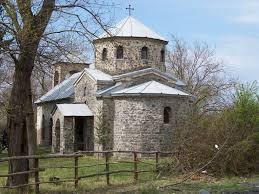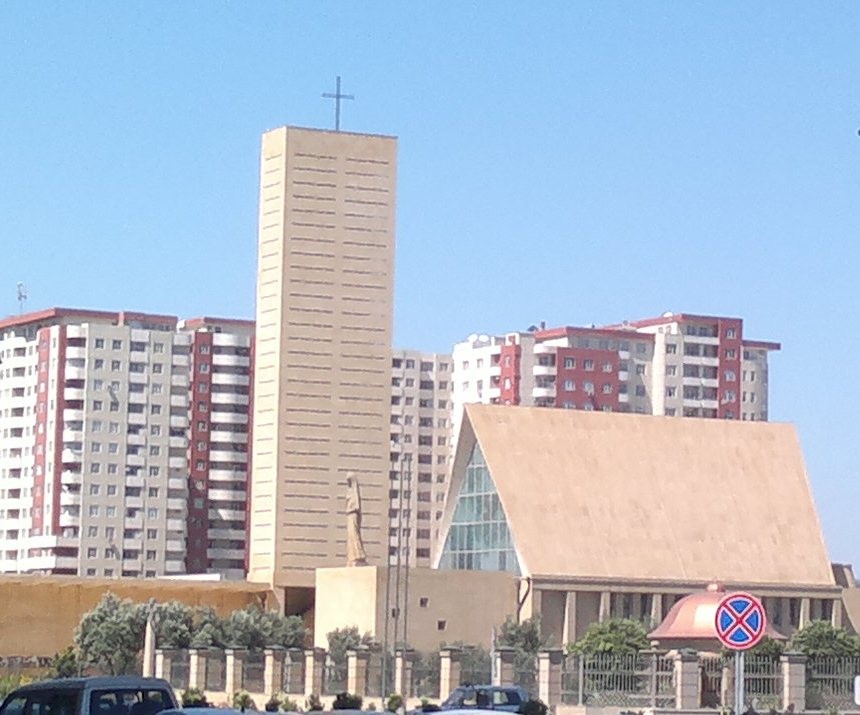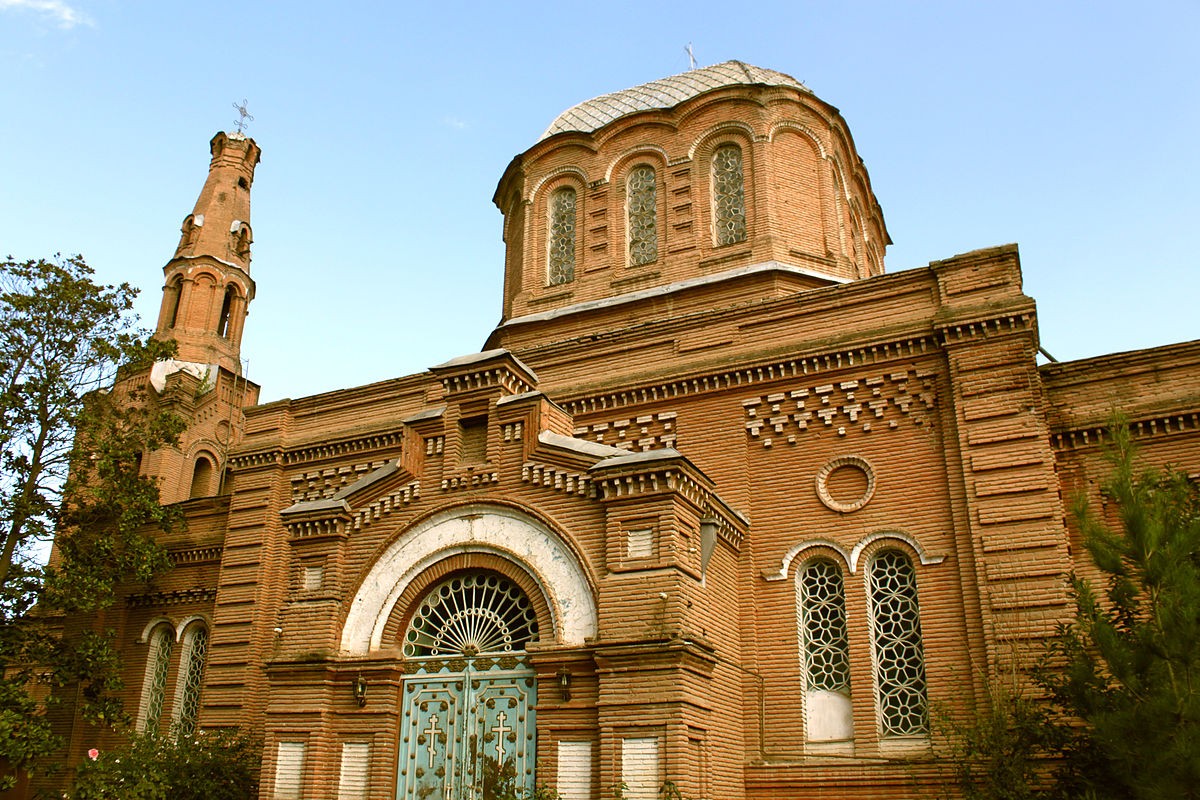Churches in Azerbaijan

Russian Orthodox churches
Orthodox Church of Michael the Archangel

Orthodox Church of Michael the Archangel is located in Yasamal district, Baku. The church of Michael the Archangel is one of the oldest Orthodox temples in Baku. Built in 1840s, the church was considered a military place of worship. According to the No.39 edition of the Caucasus newspaper issued in 1855, the temple was constructed by high-ranking officials of Caspian Maritime Administration in the honour of the chief of the Russian volunteer fleet and regiment. Its prayer room therefore initially resembled a ship deck, and it was subject to the Caspian fleet. During this period, the temple was called the Fleet Church (Russian: Flotskaya). The church was built in Pskov style. In 1873, the building of the church was transferred to Baku battalion and later to Salyan regiment. In 1875, the management of the church was handed over to the Eparchial Department.
Renovation of the church building was started with the consent of the archpriest of the military administration in 1891, and the repairs ended in November 1892. The renovation and repair work were financed by the Holy Synod and costed 22,000 roubles. New tsar’s doors and altar were installed, in addition to the modifications in other parts of the temple. All drawings were done by artist Ems.
A consecration ceremony was held in the newly renovated temple on 1 November 1892 in honour of Saint Archangel Michael by Nicholas Cathedral archpriest and grand priest Alexander Vasilyevich Yunisky together with the clerical assembly. There were a number of icons in the church, among which Saint Alexis the Metropolitan of Moscow and Divine Mother icons stood out most. These icons had been sent to Salyan regiment as gifts by the Panteleimon Monastery of Athos. There was just one altar (a little table placed in churches for implementation of some religious ceremonies) in the name of Saint Michael in the church.
On 8 November 1899, an icon in the name of Saint Archangel Michael was gifted to the church. This icon was considered to be the patron of the Salyan regiment. Archpriest Sergey Gorodtsov served as the head priest of the Church of Michael the Archangel from 1918 to 1923. Later he became Metropolitan of Novosibirsk and was regarded as a saint among Siberian people. The temple in question was closed down and turned into a hostel by the Soviet authorities in 1936. After victory over fascism, the church building was returned to the Russian Orthodox Church in 1946.
On 25 May 2001, Patriarch of Moscow and All Russia Alexy II visited the Church of Archangel the Michael, where he led a ceremony of prayer. Currently, a parish named after the Apostle St Bartholomew (place of residence of members of a lower church organisation) is being constructed on the ground floor of the temple at the initiative of Baku and Azerbaijan Eparchy archbishop Alexander Ishein.
The Holy Myrrh Bearer Women Cathedral

The Holy Myrrh Bearer Women Cathedral is a church in Baku and the headquarters of Baku Eparchy. Currently, four priests and three deacons serve in the church to meet the religious needs of the Orthodox believers. The head priest of the church is archpriest Leonid Miltykh. The church was designed by architect M. F. Verzhbitsky and built in Russian style in 1909 with personal financial assistance of millionaire and philanthropist Haji Zeynalabdin Tagiyev and through donations. The opening ceremony of the church was attended by prominent political and religious figures of the time, including Russian tsar’s Caucasian viceroy Count Vorontsov-Dashkov. In the beginning, the temple was subject to the 262nd reserve infantry regiment of Salyan and met their moral needs. In 1920, during the Soviet reign, the church was one of the first places of worship to be closed down and its head priest was shot. The temple was turned into a warehouse during the communist regime, and then placed at the disposal of sportspeople to serve as a sports hall.
During the bloody events of January 1990, the roof of the church was hit by two shells. As a result, the roof was completely destroyed, the floor collapsed and the walls were cracked. The half‑destroyed building of the temple was transferred to the Russian Orthodox Church in 1991. Following the establishment of cathedra (bishopric) in Baku, opportunities arose to perform renovation work in the church. The renovation and repair work in the temple were carried out with the assistance and care of bishop of Baku and Caspian countries, His Holiness Alexander.
During a visit to Azerbaijan on 27 May 2001, Patriarch of Moscow and All Russia Alexy II consecrated this temple and granted it the status of a main cathedral. The opening ceremony was attended by former president Heydar Aliyev, government members, embassy representatives and leaders of religious communities.
A noteworthy fact is that the church began a second chapter in its life with the personal assistance of Aydin Gurbanov, a Moscow-based Vice-President of All-Russian Azerbaijani Congress. He provided the major part of the financial and material resources required for the revival of the principal church of Baku and Caspian Eparchy. For his role in the restoration of the Russian Orthodox temple in the capital of Azerbaijan, His Holiness Patriarch of Moscow and All Russia Alexy II awarded an “Orthodox Order” to the Muslim philanthropist.
This Orthodox place of worship preserves parts of the desiccated body of Saint Bartholomew, the patron of the city.
The Church of the Nativity of the Blessed Virgin Mary

The Church of the Nativity of the Blessed Virgin Mary is a church subject to Baku Eparchy. This basilica-shaped church was built thanks to donations in 1896. From 1999 to 2001, reconstruction works were conducted in the church under the care of Baku and Caspian Eparchy bishop Alexander Ishein. On 26 May 2001, Patriarch of Moscow and All Russia Alexy II visited the Church of St. Mary, where he led a prayer ceremony. The church has a library rich in Orthodox literature, a Sunday school for children, as well as a charity dining room.
Alexander Nevsky Orthodox church
Alexander Nevsky Orthodox church is a temple in Ganja city, which was erected in 1887 in the place of an old cemetery thanks to the charitable funds of both local Orthodox Christians and Muslims. The church building was constructed out of brick in the Byzantine architectural style. Prior to the Bolshevik revolution, this Orthodox place of worship had the status of a cathedral. In 1920s, the temple was closed down by the Soviet authorities and used for other purposes. In 1946, the temple was returned to the Russian Orthodox Church. Different icons of the church’s old interior have survived to the present day, among which St. Alexander Nevsky and St. Mary Magdalene icons should be particularly noted. Ceremonies of worship in this temple are conducted on Saturdays and Sundays, as well as during Orthodox holidays.
The Church of St Nicholas the Wonderworker

The Church of St Nicholas the Wonderworker is a church located in Khachmaz district. It was originally a private house, which was converted into a church in 1946. The church has an area of 64 sq. m. The yard of the church has been renovated, and three additional rooms have been built for religious ceremonies. Acting as the religious centre for Christians of the region, the church hosts religious rites performed under the leadership of Baku and Azerbaijan Eparchy of the Russian Orthodox Church.
Georgian Orthodox churches
St George’s Church

St George’s Church is a Georgian Orthodox church located in the Ingiloy village of Gakh district. It was built in 1888 in the honour of Christian martyr St George through voluntary donations and funds provided by the Society for the Restoration of Christianity in the Caucasus. It is the main cathedral of Gakh and Kurmuk Eparchy. The area of the church building is 120 sq. m. The church is protected as a historical monument by the Ministry of Culture and Tourism of Azerbaijan. A state-registered religious community functions in the church. In 2006, President of the Republic of Azerbaijan Ilham Aliyev visited the church.
St Nino’s Church

St Nino’s Church is a Georgian Orthodox church located in the Alibayli village of Gakh district. The church was constructed with funds from the Society for the Restoration of Christianity in the Caucasus in 1871. It was used as a warehouse during the Soviet period. An overhaul of the church was commenced in 2010. On 1 June 2011, Bishop of Hereti and Khornabuji Melchizedek blessed the church.
The Church of Holy Trinity or the Church of Saint Sameba

The Church of Holy Trinity or the Church of Saint Sameba is a Georgian Orthodox church located in the Ingiloy Kotuklu village of Gakh. It has an area of 0.06 hectares and was built in 1892-1894 with funds provided by the Society for the Restoration of Christianity in the Caucasus. The church is protected as a religious and historical monument by the Ministry of Culture. It is subject to the Gakh and Kurmuk Eparchy.
St Michael’s Church

St Michael’s Church is a Georgian Orthodox church located in the Meshabash village of Gakh. The church was built in 1892-1894 with funds provided by the Society for the Restoration of Orthodox Christianity in the Caucasus and has an area of 0.03 hectares. It was renovated in 1992‑1993. The church is protected as a religious and historical monument by the Ministry of Culture.
Alban Udi churches
Chotari Church of St Elisha

Chotari Church of St Elisha is an Albanian-Udi church located in Nij settlement of Gabala district built at the expense of local residents in 1723. The church takes its name from the Chotari quarter of the settlement. During the years of Soviet rule, it was served as a hazelnut storehouse. In 2003, an overhaul of the church was started, and it opened its doors to believers in 2006.
The Albanian Church of Blessed Virgin Mary

The Albanian Church of Blessed Virgin Mary is located in Nij Settlement of Gabala district and was founded in the 12th century. It was repeatedly damaged by natural disasters and was only completed and opened for prayers in the 18th century. There was an attempt to Gregorianize the church by changing its style in the 19th century. Only after gaining state independence, the church was returned to Udis, a successor people of the Caucasian Albania. Being one of the largest churches in Azerbaijan, the Church of Blessed Virgin Mary reopened after renovations by Heydar Aliyev Foundation on 07.11.2020.
The Kala (Great) Church of St Elisha

The Kala (Great) Church of St Elisha or the Albanian temple of St. Elisha is considered a place of worship of the Udi people of Oghuz district and is located south-east of Oghuz city. It is a small, single‑hall church built in basilica style. Its location at a distance from the residential settlement, near the mountain and on a high hill by the river Oghuz makes it likely to be an apostolic type of church.
The building of the temple has a rectangular shape and a width of 5.55m and length of 7.45m from the outside. The dimensions of the prayer hall are 3.50m by 4.35m.
This monument was erected in honour of Elisha, one of the saints of the Christian church, and served as the place of worship of local Albanian tribe Udis. After the Turkmenchay treaty of 1828, part of the Armenians resettled by the tsarist Russia from Iran and Ottoman Empire into Azerbaijani lands were settled in Oghuz district, and as a result, the St. Elisha basilica, like our other historical and religious monuments, suffered Armenian aggression. It was renamed as Yeghishe Arakel monastery by Armenians, its Albanian inscriptions were destroyed and replaced by Armenian ones, and the Albanian cross was substituted with the Armenian cross.
Catholic church
The Catholic Church of Holy Virgin Mary’s Immaculate Conception (Innocent Mother Mary)

The Catholic Church of Holy Virgin Mary’s Immaculate Conception (Innocent Mother Mary) is located on Shamil Azizbayov Street in Baku. The Catholic church of Holy Mother Mary was inaugurated on 7 March 2008. Azerbaijani President Ilham Aliyev attended the opening ceremony. The church was constructed based on the design of Paolo Rujeiro, a professor of the Naples University of Architecture, and chief architect of Baku Akif Abdullayev. Built in modern style on a surface area of 1,256 sq. m., the church has heating, ventilation and fire-extinguishing systems. The construction work was financed by the Vatican State. There is a plaque on the entrance to the building showing the date of foundation and names of the architects and construction company. The church has a room where 250 to 300 people can pray at once.
The “Jesus the Intercessor” Catholic church

The “Jesus the Intercessor” Catholic church is located near the Ganjlik metro station, in the two-storey detached house belonging to the Catholic congregation. A large hall on the first floor of this 7-room building has been designated for the “Jesus the Intercessor” temple. The temple can accommodate 42 worshippers at a time. Religious rites are conducted in Russian. In addition, the building housing the church also hosts the office of the Ordinary and a monastery of Salesian monks.
Lutheran church
The “Saviour" Evangelic-Lutheran church (German: Erlöserkirche)

The “Saviour" Evangelic-Lutheran church (German: Erlöserkirche), also known as the Church of the Saviour, is a German Lutheran church in Baku, which was built in 1896-1899 in neogothic style based on the design of German architect Adolf Eichler.
The grand foundation-laying ceremony of the church took place on 21 March 1896 and was attended, among others, by Baku governor Pavel Lileev and mayor Iretski. The church was erected thanks to donations by believers, including Nobel brothers, and cost 70,000 roubles.
On 24 June 1898, a 13-pood gilded cross was raised to the top of the church tower. The production cost of the cross of 15,000 roubles was covered by Bruno de Bur, a brother of the Lutheran community chairman Lev de Bur. In 1899, bells and an organ were installed in the church, and the first organ music was played in the church on 4 February 1899. The blessing ceremony of the “Saviour” Lutheran Church of the German-Swedish congregation took place on 14 March 1899 and was attended by more than a thousand people, including governor Vladimir Rogge.
On 23 April 1900, the church hosted its first religious organ concert, where the works of I. S. Bach were played. Afterwards, such concerts became a tradition and continued until 1928.
During the years of independence, the church was named a Hall of Chamber and Organ Music by the decision of the Cabinet of Ministers and was subordinated to Azerbaijan State Academic Philharmonic Hall.
On 15 March 2010, considering the importance of the building of the Hall of Chamber and Organ Music as a historical and architectural monument and a cultural centre, President Ilham Aliyev signed an order for the restoration of the building.
1 million AZN was allocated from the Reserve Fund of the President of the Republic of Azerbaijan for the implementation of restoration. Following a year of restoration process, on 30 December 2010, President Ilham Aliyev and First Lady Mehriban Aliyeva attended the opening ceremony of the church building. The overhaul was carried out by Azerbaijani specialists by preserving the unique original style of the building and its ancient historical architecture. Special attention was paid to the acoustics of the building, which is one of the most beautiful specimens of the traditional German gothic architecture. In addition, a ventilation system was installed in the building for the first time ever, and the organ was repaired by specialists invited from abroad.
Currently, the church continues to operate as the Hall of Chamber and Organ Music of Azerbaijan State Academic Philharmonic Hall.







